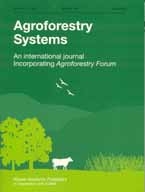| Journal Article |
 |
|
| Article Title | Can the ecosystem mimic hypotheses be applied to farms in African savannahs? | | Author | Meine van Noordwijk and Chin K Ong | | Year | 1999 | | Journal Title | Agroforestry Systems | | Institution | Kluwer Academic Publishers | | Volume | 45 | | Issue | 1-3 | | Pages | 131-158 | | Call Number | JA0137-04 | | Keywords | Ecosystems, Agroforestry systems, Canopy, Plant competition, Crop yield, Hydrology Land use, Productivity, Savannas, Soil fertility |
|
| Abstract: |
| Two ecosystem mimicry hypotheses have been suggested. The first hypothesis suggests clear advantages if man-made land use systems do not deviate greatly in their resource use patterns from natural ecosystems typical of a given climatic zone. The second hypothesis claims that additional advantages will accrue if agroecosystems also maintain a substantial part of the diversity of natural systems. These hypotheses are discussed for the savanna zone of sub-Saharan Africa, with its low soil fertility and variable rainfall: the structure and function of the savannas are first described, and then the structure and function of agroecosystems (parkland agroforestry systems) in the savanna zone are addressed; the last part of the paper discusses the reduction of risk through diversity.
Where annual food crops replace the natural grass understorey of savanna systems, water use will decrease and stream and groundwater flow change, unless tree density increases relative to the natural situation. Increasing tree density, however, will decrease crop yields, unless the trees meet specific criteria. Food crop production in the parkland systems may benefit from lower temperatures under tree canopies, but water use by trees providing this shade will prevent crops from benefiting. In old parkland trees that farmers have traditionally retained when opening fields for crops, water use per unit shade is less than in most fast growing trees introduced for agroforestry trials. Strong competition between plants adapted to years with different rainfall patterns may stabilize total system productivity - but this will be appreciated by a farmer only if the components are of comparable value. The best precondition for farmers to maintain diversity in their agroecosystem hinges on the availability of a broad basket of choices, without clear winners or 'best bets' |
|
|
Download file(s): Click icon to download/open file.
|
| |
File Size |
Description |

|
168 KB |
Softcopy |
|
|
|
| Viewed in 3699 times. Downloaded in 867 times. |